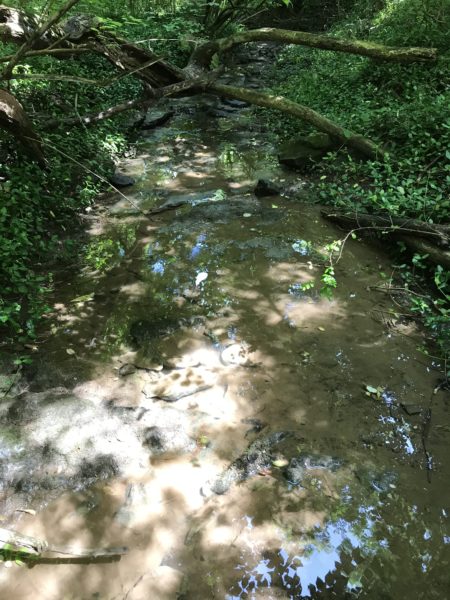The Tennessee Department of Environment & Conservation has confirmed that the endangered streamside salamander, Ambystoma barbouri, lives in the streams behind Studio 615, in the undeveloped soon-to-be mixed use property Broadmoor Woods. The salamander’s home also shares land with a soon-to-be residential property that borders Broadmoor Woods.
Thankfully, both Christian Paro (C615 owner) and the other property owner have agreed to take necessary measures to preserve the habitat of the endangered salamander species. David Ian Withers of the TN Dept. of Environment & Conservation visited the site with them and suggested measures to consider in site designs to ensure the native amphibians can thrive.
Credit for discovery of the species goes to Brooke Heriges of TDEC’s Division of Water Resources, who first found the little fellas April 20, 2021.
Streamside Salamanders
Listed as state endangered by the Tennessee Wildlife and Resources Agency in August 2018, the salamander species Ambystoma barbouri lives in limestone habitats near slow flowing streams that run through gently sloped upland forests. They boast brown, gray, and black hues with slimy speckles and grow to about 5 inches in length. The adults live entirely underground except during breeding season. In late autumn, they come out of the ground and migrate to a breeding location, such as a wetted limestone slab near a stream. Barbouri then begin their breeding season in December, going through March. Barbouri will lay their eggs on the underside of submerged rocks, wetted logs, or even the stream bottom. Once the larva hatch, they live in the streams for no more than eight weeks. When the streams dry up in the late spring, these young barbouri then seek or dig their way to a high humidity environment below ground. The metamorphosed salamanders remain in their new homes perhaps until they reach full maturity four to five years later. Mature salamanders will venture above ground to breed soon after gentle water flow returns to the streams in late fall.
The streamside salamander, along with most amphibians, are a vital link in the food chain between invertebrate species that live in streams (insects, worms, snails, and crayfish), and the vertebrate species that live by the stream (frogs, lizards, and birds).


Property Plans
Thankfully, Christian’s development plans for Broadmoor Woods do not interfere with the current streams where the salamanders live. To help the salamander population further, they are removing invasive plant species and planting beneficial native trees.
The other property currently has a manmade pond where mosquitofish and sunfish, both predators of the streamside salamander, flourish. Between 2004-2010, the previous owner of the land had excavated material to fill in a five hundred foot portion of a natural seasonal stream. The owner filled in his land to create a hay pasture and created a pond in the process.
Tennessee LiDAR maps and other images on Google Earth indicate a strong possibility of a natural spring underneath the man made pond. To hopefully revive the naturally occurring seasonal stream, the plan is to strategically drain the pond. Additionally, draining the pond should severely reduce—and possibly eliminate—mosquitofish and sunfish from the stream system to further help protect the existing salamander population.
Another proposed plan is to engineer stormwater basins in a way that directs rain water to create a shallow, seasonal wetland habitat, where the streamside salamander can successfully breed.
The final possible plan is to hand place limestone slabrocks in the stream to encourage the salamanders to lay more eggs in the existing area. More eggs = more salamanders = hopefully reviving the endangered species.
The Discovery Story
I had the privilege of speaking with David Withers to learn more about the story behind the discovery, and the significance of the state endangered barbouri presence on C615 property.
Prior to the TWRA declaring the streamside salamander state endangered in August 2018, the species was “deemed in need of management.” They suspected the species was in decline, but because the barbouri spend a majority of their adult life underground, it can be hard to track the exact size of any population. Attributed reasons for the population decline include the failure of stormwater control measures, sedimentation, channelization, loss of flow, drought, and other stochastic weather events.
Due to dry weather spells, the difficulty of tracking the species, and the recent residential development boom, TWRA decided to bump the species to state endangered in order to heighten awareness and promote consideration of the species in site development planning.
To better understand Tennessee populations, the TWRA supported David Withers and the Tennessee Division of Natural Areas by funding a study to determine the state’s geographical range of the streamside salamander. So, he began to scope small streams and landforms that would possibly support the life cycle of barbouri.
His colleague Brooke Heriges sparked a casual conversation with David about a hydrological determination review for a future property development. Based off an aerial image during winter 2003-2004, the topography of the site looked promising for the potential to find the barbouri somewhere on the property. So, when Brooke sent David photos of amphibian larvae she found living in one of the site’s streams, he knew they had found a goldmine.
This discovery prompted David to reach out to the two property owners and request a thorough inspection of the streams that cover both properties. His visit confirmed the first sighting of the endangered streamside salamander in the Whites Creek system—what David called “the holy grail.” He is thrilled that both Christian and the other property owner are more than willing to help protect and encourage the barbouri population.
Next winter during egg-laying season, David hopes to revisit the site to find and document how many eggs have been laid, as counting egg masses is a common way to track the breeding success of this endangered species.
This Whites Creek site is one of few currently known in Davidson County. If all goes accordingly, improvements to Broadmoor Woods and its sister project have the potential to vastly enhance the salamander’s breeding success in this tributary system. One day residents and visitors may have the chance to see this rarely encountered species.
Note to all readers: if you have a creek in your yard, let it do its natural thing.
Want to hear more about Center 615 and our services? Click here.





